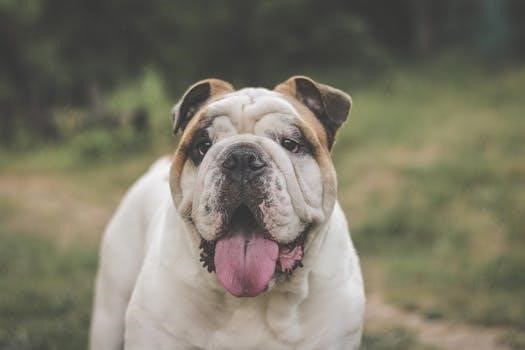
This guide offers key insights into feeding your English Bulldog puppy, ensuring their healthy development. It covers frequency, portion sizes, and consistent schedules. Proper feeding is crucial for your puppy’s well-being, so understanding these guidelines is essential for every owner. This text will help you navigate feeding your new family member.
Feeding Frequency for Young Puppies
Young English Bulldog puppies require frequent meals to support their rapid growth and high energy levels. During the first few weeks, when puppies are under constant care, they will need feeding every three hours to maintain their health. As they grow, the frequency will gradually decrease. Typically, puppies need to be fed at least three to four times a day until they are around six months old. This frequent feeding schedule ensures they receive the necessary nutrients for healthy development. After six months, the feeding schedule can be reduced to twice a day. It is essential to provide small meals to your puppy rather than large ones, ensuring they can digest their food properly. At approximately two weeks of age, puppies will require round-the-clock care which also includes feeding intervals of around three hours. As they grow they will need less attention, and their feeding frequency will decrease. For optimal health, always consult with your veterinarian for personalized advice on feeding frequency as well as portion size.
Transitioning to Fewer Meals
As your English Bulldog puppy grows, it’s crucial to transition from frequent meals to a less demanding feeding schedule. Typically, this transition begins around six months of age when they no longer require three to four meals daily. The reduction should be gradual to allow their digestive system to adapt. Most puppies can transition to two meals a day, which is generally around 12 hours apart. This change usually coincides with a change in their activity level and growth rate. When moving to fewer meals, it’s important to ensure that the total daily food intake remains appropriate for their age and weight, and it is essential to maintain consistency in feeding times. The amount of food during these two meals should be adjusted so as not to cause digestive issues; This adjustment is essential for their overall well-being and weight management, and always consult with your veterinarian for specific recommendations based on your pup’s individual needs and activity level. This will ensure a healthy transition as they mature.
Recommended Meal Schedule

Establishing a consistent meal schedule is vital for your English Bulldog puppy’s well-being. For young puppies, it is generally recommended to feed them three to four times a day, spread evenly throughout the day; As they grow, typically around six months, you can transition to two meals a day. A common schedule for adult Bulldogs involves feeding once in the morning, around 7⁚00 am, and again in the evening, around 7⁚00 pm, with a 12-hour interval between meals. For puppies, these intervals could be shorter, like 4-6 hours between feeds. Consistency in feeding times helps regulate their metabolism and digestion, and it also prevents overeating. It’s important to remember that this is a general guideline, and you should always adjust based on your puppy’s activity level and individual needs. Providing regular and timely meals helps your puppy establish a healthy routine, contributing to a well-balanced life. It is always good to consult with a vet as well.
Importance of Consistent Feeding Times
Maintaining consistent feeding times is paramount for your English Bulldog puppy’s health and well-being. A regular schedule helps regulate their digestive system, ensuring optimal nutrient absorption. When meals are provided at predictable times, it reduces the likelihood of digestive issues such as indigestion or bloating. Furthermore, a structured feeding routine can help prevent overeating and obesity, which are common concerns in this breed. Consistent meal times also aid in housetraining by establishing a more predictable elimination schedule. This predictability reduces stress and anxiety in your puppy, making for a happier and healthier pet. A regular feeding schedule also allows you to better monitor your puppy’s appetite and notice any changes that may indicate health problems. It also creates a sense of routine and security for your pup. Ultimately, a consistent feeding schedule is an essential component of responsible pet ownership.
Food Portion Sizes for Puppies
Determining the correct food portion sizes for your English Bulldog puppy is crucial for their healthy growth and development. Puppies require specific amounts of food based on their age, weight, and activity levels. Overfeeding can lead to obesity, while underfeeding can hinder their growth. A general guideline for young puppies is to start with smaller, more frequent meals throughout the day, gradually increasing the amount as they grow. For example, a 7-week-old puppy weighing 8-12 pounds should receive a specific amount of puppy food per meal, usually spread across three to four meals daily. As they reach 12 weeks, the amount may increase to around 1.5 to 2 cups of food per day. It’s essential to monitor your puppy’s weight and adjust portion sizes accordingly. Consulting with your vet and using a puppy feeding chart will help you ensure your puppy receives the correct amount of nutrients. Always follow the recommendations on the puppy food packaging as well.
Calorie Needs Based on Age
Understanding the calorie needs of your English Bulldog puppy as they age is vital for their health and development. Younger puppies, especially those under six months, require a higher calorie intake to support their rapid growth and energy expenditure. Typically, they need more calories per pound of body weight compared to adult dogs. At around 2 weeks old, puppies are still dependent on their mother’s milk, receiving frequent feedings approximately every 3 hours. As they transition to solid food, their calorie intake needs to be carefully monitored and adjusted. An 8-week-old puppy might require around 25-30 kcal per day. As they grow, this requirement will change. Adult English Bulldogs generally need about 20-30 calories per pound of body weight, while senior dogs may need less, around 20-25 calories per pound. It’s essential to consult with your veterinarian to determine the precise calorie needs for your puppy, taking into account their specific age, weight, and activity level. Regular monitoring of their weight and adjusting the calorie intake as they grow is crucial to prevent overfeeding or underfeeding;

Adjusting Food Based on Activity Level
The amount of food an English Bulldog puppy needs isn’t just about their age and size; their activity level plays a significant role. Puppies that are highly active, constantly playing and exploring, will naturally burn more calories than those that are more sedentary. Consequently, their food intake should be adjusted to meet this increased energy demand. If your puppy is engaged in regular exercise, like walks and play sessions, you may need to slightly increase their food portions to ensure they maintain a healthy weight and have enough energy. Conversely, if your puppy is less active, such as spending a lot of time resting, overfeeding can lead to weight gain. It’s important to monitor your puppy’s body condition regularly. Feel their ribs – they should be easily felt but not prominently visible. If you notice your puppy is gaining weight or becoming too thin, adjust their food portions accordingly. Remember that treats should also be factored into their daily calorie intake. It is essential to find a balance so that your puppy is getting the right amount of food to support their level of activity, this will help your puppy to stay healthy and happy.

The Importance of a Feeding Chart
A feeding chart is an invaluable tool when raising an English Bulldog puppy, providing a structured approach to their nutritional needs. This chart helps track your puppy’s growth and ensures that they receive the appropriate amount of food at each stage. It typically includes details on age, weight, and recommended food portions, serving as a clear guide to avoid over or underfeeding. A well-maintained feeding chart allows you to monitor your puppy’s progress and make necessary adjustments to their diet as they grow, ensuring a healthy weight gain. It also aids in establishing a consistent feeding routine, which is crucial for your puppy’s digestive system. The chart can also be updated with any changes in their activity level or food brand. Using a feeding chart will help you avoid confusion and ensure that your puppy gets the right amount of nutrients. Furthermore, a feeding chart is beneficial when there are multiple caregivers, ensuring everyone is on the same page and follows the same feeding plan, this will help prevent confusion and inconsistencies with feeding, ultimately contributing to your puppy’s overall health and well-being.
Food Accessibility and Bowl Height
Ensuring that your English Bulldog puppy can easily access their food is crucial for their comfort and well-being. Due to their unique physical structure, especially their short muzzles, traditional food bowls may not be suitable. The bowl should be shallow and wide enough to allow them to eat without straining or difficulty. A bowl that is too deep or narrow can make it challenging for them to reach the food, leading to frustration and potential mess. The bowl’s height is also important, it should be placed at a level that allows your puppy to eat comfortably without having to excessively bend or stretch. If the bowl is too low, it can cause strain on their neck and back, while an overly high bowl can lead to discomfort and potential choking hazards. Therefore, an appropriate bowl will help prevent digestive issues. An elevated bowl can help as long as it is not excessively high, so it is important to monitor your pup. Remember that proper food accessibility is an important aspect to consider for your puppy’s overall feeding routine; Ensure your puppy can reach the food without stress.
